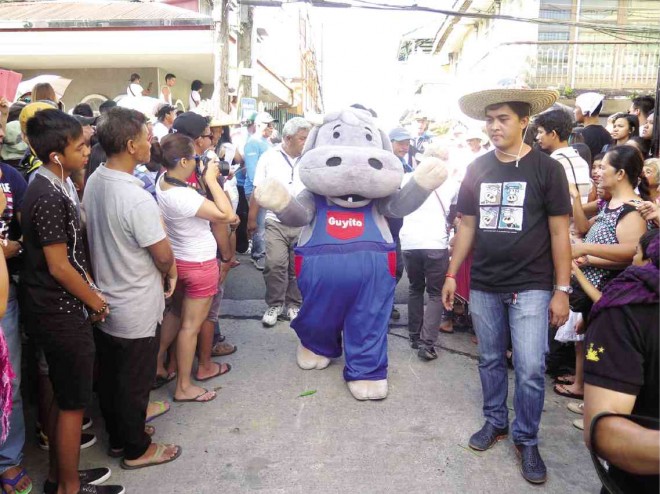
GUYITO, the Inquirer mascot, is greeted by the crowd at the Pahiyas Festival, which is held yearly in Lucban, Quezon province, in honor of San Isidro de Labrador, the patron saint of farmers. DELFIN T. MALLARI JR./INQUIRER SOUTHERN LUZON
LUCBAN, Quezon—The popular Pahiyas Festival of this town has not only been attracting a multitude of tourists, but is also calling on natives of this bucolic town at the foot of Mount Banahaw to come home.
“The moment the church bells ring, it’s time for Lucbanins to come home,” said Maria Luisa Obmerga, an architectural designer born and raised in Lucban but is now based in Pasay City.
Obmerga was referring to the pealing bells of the parish church, which echoes across town on special occasions like the Aug. 19 fiesta and the Pahiyas, the feast honoring the town’s patron saint, San Isidro de Labrador, on May 15.
Pahiyas, a feast of thanksgiving for a bountiful harvest, is known for its exquisite display of multicolored “kiping” (colorful rice-based wafers elaborately arranged like chandeliers), fresh harvest and other native products in every house along the procession route.
The Department of Tourism has included the farming town of Lucban in its list of must-see tourist destinations, owing to its rich cultural history, color and gaiety.
Fr. Noel Cabungcal, parish priest, said the devotion of the residents in celebrating the feast of San Isidro was a manifestation of the deep spirituality of the Lucbanin.
“To those who will take a selfie with Pahiyas as background, the colorful displays are not mere decorations. They are revered symbols of our gratitude to the Lord,” Cabungcal said in an interview.
“Most of us want to time our (home visit) during Pahiyas to once more experience this unique local celebration,” Obmerga said on Thursday as she supervised the decoration of their ancestral house.
For most returning natives, nothing brings her more joy than decorating the family home with kiping. “There’s a distinctive feeling of happiness,” she said.
Vibeth Racelis, proprietor of Racelis noodle factory which produces the popular “pancit Lucban,” the eve of the festival is spent cooking two favorite fiesta dishes—“embuitido” (steamed meat loaf) and “hardinera,” a loaf of diced pork.
Another native now working in Makati City, Jason Saludes, said Pahiyas had long been the favorite occasion of the members of his clan to go home, even those coming from the United States. “They have long been missing the fun,” he said.
Councilor Cornelio Rañeses, president of the Lucban Historical Society, said the festival had been a boost to the local economy, particularly to makers of the “longganisang Lucban” and pancit Lucban.
According to a member of festival committee, the grand prize winner for this year’s most beautiful decoration will receive P150,000. More than 700 are participants this year, compared to last year’s 600.
“Maybe for some, the decorations are no longer grand as before in order to save money. But they still put on some displays as a sign of respect to San Isidro,” she said.
The Philippine Daily Inquirer sponsored the parade of 15 carabaos, called “bikas gayak,” which means “well-adorned,” as a tribute to the farmer and the carabao, a symbol of the hardworking Filipino.
Guyito, the Inquirer’s popular mascot, led the participants and waved to the crowd. Farmers with decorated wooden sledges joined the parade.

